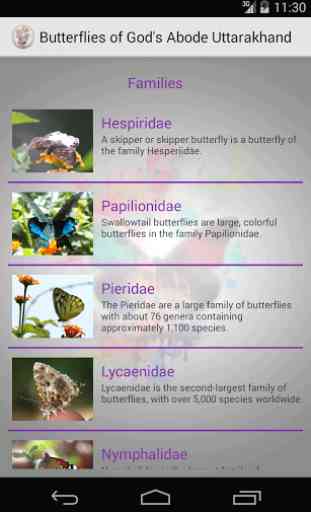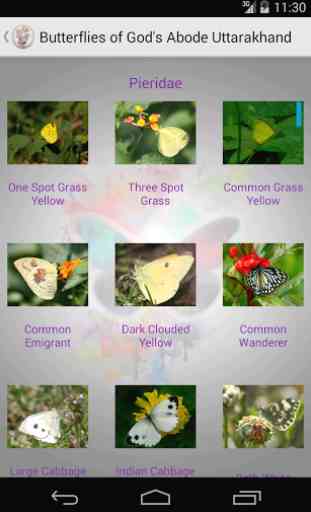Butterflies of God's Abode
The mobile App “Butterflies of God’s Abode, Uttarakhand” is a concise field guide to the common butterflies of Uttarakhand. It covers ……. most commonly found species of butterflies. The species covered in the app are classified into five families and further search within the families gives details like the scientific name, status, wingspan etc as well as a comprehensive account on the natural distribution of the species in the Indian sub-continent, behaviour and their morphological description. The photographs of butterflies appearing in the app were obtained by the IFS officers of 2010 during their field visits and tours in Uttarakhand.
Uttarakhand is referred to as the Devbhumi or God’s Abode due to the many Hindu temples including the Char Dhams and pilgrimage centrs found throughout the state. Uttarakhand has a total area of 53483 sq. km, of which 86% is mountainous and 71% is covered by forest. Uttarakhand lies on the southern slope of the Himalaya range, and the climate and vegetation vary greatly with elevation. The highest elevations are covered by ice and bare rock. Below them, are the Western Himalayan alpine shrub and meadows (3000-5000 m). The temperate Western Himalayan sub alpine conifer forests grow just below the tree line. At 3000
- 2600 m elevation, the vegetation changes to the temperate Western Himalayan broad leaf forests, which lie in a belt from 2,600 to 1,500 m elevation. Below 1,500 m elevation lie the Himalayan subtropical pine forests. The Upper Gangetic Plains moist deciduous forests and the drier Terai-Duar savanna and grasslands cover the lowlands along the Uttar Pradesh border in a belt locally known as Bhabar. Four major river systems originate from the state, viz., Ganga, Yamuna, Ramganga and Sharda. The major wealth of the state is its forests with very rich biodiversity. The state is represented by biographic zone 2B Western Himalaya and 7B Shiwaliks consisting of Kumaon and Garhwal two regions. The average annual rainfall is 1550 mm. The varied climate and vegetation caters to rich diversity of both flora and fauna.
Uttarakhand is referred to as the Devbhumi or God’s Abode due to the many Hindu temples including the Char Dhams and pilgrimage centrs found throughout the state. Uttarakhand has a total area of 53483 sq. km, of which 86% is mountainous and 71% is covered by forest. Uttarakhand lies on the southern slope of the Himalaya range, and the climate and vegetation vary greatly with elevation. The highest elevations are covered by ice and bare rock. Below them, are the Western Himalayan alpine shrub and meadows (3000-5000 m). The temperate Western Himalayan sub alpine conifer forests grow just below the tree line. At 3000
- 2600 m elevation, the vegetation changes to the temperate Western Himalayan broad leaf forests, which lie in a belt from 2,600 to 1,500 m elevation. Below 1,500 m elevation lie the Himalayan subtropical pine forests. The Upper Gangetic Plains moist deciduous forests and the drier Terai-Duar savanna and grasslands cover the lowlands along the Uttar Pradesh border in a belt locally known as Bhabar. Four major river systems originate from the state, viz., Ganga, Yamuna, Ramganga and Sharda. The major wealth of the state is its forests with very rich biodiversity. The state is represented by biographic zone 2B Western Himalaya and 7B Shiwaliks consisting of Kumaon and Garhwal two regions. The average annual rainfall is 1550 mm. The varied climate and vegetation caters to rich diversity of both flora and fauna.
Category : Education

Related searches
Reviews (5)
ksh. v.
Mar 7, 2015
Very good initiative to promote conservation cause by IT intervention
A. G. u.
Mar 7, 2015
Good application with short and sweet information.....
nai.
Mar 6, 2015
Dear batchie ...its too good
Dhr. J.
Apr 13, 2015
Nice info collection





Marvellous source of information. I was looking for such an app for a while. Now i have it. Great work done by the team.